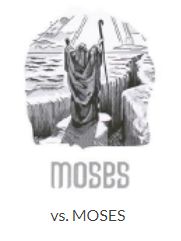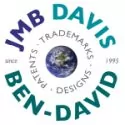
After completion of successful examination, a trademark application filed in Israel will be published in the online Israel Trademarks Journal. During the three-month period following publication, any interested third party, on good grounds, may file a notice of opposition. If the opposition is successful, the application is rejected and the mark is not registered. If no opposition is filed, or if an opposition is not successful, the mark is duly entered into the Israel Trademarks Register.
Israel Trademark Application 267843 was filed on August 24, 2014, for a mark consisting of the word "MOSES" and the image of the biblical figure Moses splitting the Red Sea. The application was filed in International Class 33 relating to alcoholic beverages. During the opposition period, the Israeli restaurant chain MOSES, filed a notice of opposition. The Opposer holds two prior registered trademarks containing the word "MOSES" – IL TM 192204 (non-stylised word mark "MOSES", in class 30 for dressings, salad dressings, ketchup, mustard, mayonnaise, and in class 43 for providing foods and beverages, restaurant services), and IL TM 222667 (non-stylised word mark "MOSES STATION", in class 43 for restaurant services, take-away services, providing food and beverages). The Opposer also holds ILTM 192206 for the image of a dog/cat in classes 30 and 43.
Grounds for the Opposition
The Opposer based its opposition on multiple grounds. The main argument was that IL TM 267843 was ineligible for registration based upon Section 11(14) of the Trademarks Ordinance [New Version] 5732-1972 (the "Ordinance") as amended in 5760-1999. This subsection provides that a mark is not eligible for registration in circumstances where:
"A mark that is identical to or resembles a well-known trademark that is a registered trademark, and this even if it is in respect of goods that are not of the same description, if the mark whose registration is being requested could indicate a connection between the goods in respect of which the mark is required and the proprietor of the registered mark, and the proprietor of the mark is liable to be adversely affected as a result of the use of the requested mark."
The Opposer claimed that its registered trademark for "MOSES" (IL TM 192204) was a well-known mark, and the verbal component of the requested mark was identical to it. The Opposer admitted that its registered trademark and the requested mark were in different classes but argued that there was a connection between the goods of the requested mark (alcoholic beverages) and the goods of its registered marks (restaurant services, food, and beverages). The Opposer asserted that the registration of the requested mark would lead to consumer confusion and cause harm to its reputation. In addition, the Opposer claimed that they do sell alcoholic beverages, even though their marks are not registered in class 33, and for this reason as well registration of the requested mark would cause confusion.
In addition, the Opposer claimed the requested mark was ineligible for registration under Section 11(6) of the Ordinance:
"Marks likely to deceive the public, marks which contain false indications of origin and marks which encourage unfair trade competitions".
The Opposer argued that the requested mark is likely to mislead the public, such that when the public would purchase the product of the Applicant, they would believe they are buying the Opposer's products. The Opposer asserted that since it had acquired a considerable reputation in the restaurant market, the exploitation of their reputation by the Applicant of the requested mark would cause unfair competition, erosion of the uniqueness of their marks and dilution of their marks.
Another claim by the Opposer was that the requested mark was ineligible for registration based on Section 11(7) of the Ordinance:
"Marks identical with or similar to emblems of exclusively religious significance".
The Opposer claimed that the image and text shown on the requested mark is clearly of religious significance, and is therefore ineligible for registration.
The last claim by the Opposer that the requested mark was ineligible for registration was that in the event of registration of the requested mark, any use of it would fall within the category of passing-off, as defined in the Commercial Torts law.
Rebuttal of the Applicant
The Applicant in return argued that the word "MOSES" is descriptive, generic, and general, such that the Opposer's mark is very weak. In addition, the Applicant noted that the Opposer does not use the word MOSES alone as their trademark, rather they use it in combination with the image of the cat/dog, or as MOSE*S in a unique font. In any event, the Applicant argued that there is no misleading similarity between the marks, in accordance with the accepted standard used to determine if there exists a likelihood of consumer confusion between the marks, the tri-partite test.
The Applicant stated that if the Opposer had acquired goodwill in connection with their trademarks, it was in the field of hamburger restaurants, and that this was not relevant to the business domain of their mark, namely, the field of alcoholic beverages. The Applicant asserted that given the vast differences in the goods and marks, the Applicant had no intent of piggybacking or passing-off on the goodwill of the Opposer.
Judge`s Analysis and Decision
In her decision, the Judge of IP matters in the Israel Patents, Designs, and Trademark Office ("the Judge") first addressed the question of whether the Applicant's mark (that is a combination of the image of Moses splitting the Red Sea and the name "MOSES") was "confusingly similar" to the Opponent's registered mark for "MOSES" under Sections 11(6) and (9) of the Ordinance. She stated that this required applying the "tri-partite test" that involves the following three components: 1) comparing the visual images of the marks and their sound; 2) comparing the classes of merchandise and the types of consumers of the products/services; and 3) evaluating specific circumstances of each case.
However, before doing so, the Judge first addressed the issue of the strength and the scope of protection that should be accorded to the Opposer's mark (MOSES). This mark is a word mark, without any design element, which generally grants to the owner a broad protection applied to all uses of the word. In addition, the Judge stated that the name MOSES is arbitrary in relation to the goods/services of the mark as registered, and therefore, in principle, the mark should be accorded broad protection. However, the Judge also noted the name Moses is a common first name and a universally recognized biblical figure, and for that reason should be available for use by the public and not be unduly restricted by the registration of the word as a trademark.
How the Judge applied the tri-partite test to the facts at hand:
- Image and sound test – this is the most important of all three components of the test. Firstly, the visual and aural aspects of the verbal components of the marks are compared, disregarding the images. In this case, the two marks are identical, and therefore arguably are confusingly similar despite the fact that the Applicant's mark includes an image. However, the Judge ruled that "an exception to this rule occurs when the mark of a later application includes a design component that is so unique that it overshadows the verbal similarities." The Judge ruled that the exception applies here, noting that the image of Moses splitting the Red Sea of the requested mark is the dominant component and the word Moses is a small part of the mark.
The Judge further noted that according to the evidence submitted by the Opposer itself, it appeared that their consumers were not exposed to the word MOSES alone but rather to a unique stylized form of the word (MOSE*S) with or without the dog/cat image, and she concluded therefore that "there is a high probability that the designed form has been burned into the consumer's consciousness" and not merely the simple word "MOSES" .
- Classes of merchandise, and type of consumers test– The question to be asked is, are the marks within the same "commercial family", such that consumers would conclude that there is a connection between the marks. The Judge stated that at face value alcoholic beverages and restaurant services are within the same commercial family. In relation to the consumers, the Judge determined that the consumers would be the general population and are the same.
- Specific circumstances of the case test- Here the Judge has to determine if in view of the circumstances of this case were there reasons to conclude that the marks would cause consumer confusion. The litmus test is whether the public, applying common sense, would err and confuse the goods of both parties. The Judge agreed with the Opposer that their mark had acquired distinctiveness and that MOSES in combination with the image of the cat/dog, is a known brand in Israel. However, the Judge noted that the conceptual message of the brand conveyed is young, abstract, and a bit amusing and has nothing to do with biblical Moses. This, in contrast to the requested mark which is a realistic and classic image, with a clear connection to the biblical figure, Moses. The requested mark conveys a message of seriousness. Therefore, the Judge determined that the potential for consumer confusion between the two marks in this case is non-existent.
In order to determine if there was any weight to the claim made by the Opposer under Sections 11(14) of the Ordinance, the Judge had to determine if the Opposer's mark was a "well-known" mark and therefore should be accorded broad protection.
The threshold necessary in order to prove a mark is well-known is very high. This is because the protection given to a well-known mark is considerable. Concrete evidence must be brought by the party proving they it indeed is "well-known". The Judge ruled that according to the evidence brought by the Opposing party their mark is a brand known to the public in Israel, but she ruled that the evidence was insufficient to support the claim that it had become a well-known mark.
To determine if there was any weight to the assertion made by the Opposer under Sections 11(7) of the Ordinance, the Judge had to evaluate if the mark is a religious emblem. There is no contention that the visual and verbal component of the requested mark has religious significance, but was the intent of the Ordinance to block any registration relating to such? The Judge stated that an emblem is "by definition a symbol that represents something". In this instance the verbal component of the requested mark is Moses, and the visual image represents Moses splitting the Red Sea, but there are a plethora of stories from the Bible that could represent Moses, and therefore the Judge ruled that the requested mark does not constitute the use of an emblem.
Lastly, the Judge addressed the claims of the Opposer that the use of the requested mark would cause unfair competition, exploit their reputation, and cause dilution of their marks. In order to determine such, the Judge had to determine the level of reputation acquired by the Opposer in connection with their mark, and in what domain. The Opposer's mark is a brand, but since the goods are not overlapping (hamburger restaurants vs. alcoholic beverages) she ruled that the owners of the requested mark are not piggybacking on the reputation of the Opposer, nor do they create unfair competition. The Judge did not give any credibility to the Opposer's claim of dilution, since the doctrine of dilution only relates to well-known marks, and the Judge had already established that the Opposer's mark is not well-known.
Conclusion
In view of the above analysis, the Judge dismissed the motion to oppose the registration of IL TM 267843, after concluding that there is no likelihood of confusion with the Opposer's marks. Although the Opposer may have believed that it had valid grounds for opposing the registration of the requested mark, this important decision teaches us that trademark law is not always black and white, and exceptions do apply, such as in the words of the presiding judge: "an exception...occurs when the design component of the mark is so unique that it overshadows the verbal similarities".
The content of this article is intended to provide a general guide to the subject matter. Specialist advice should be sought about your specific circumstances.

